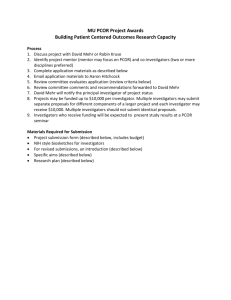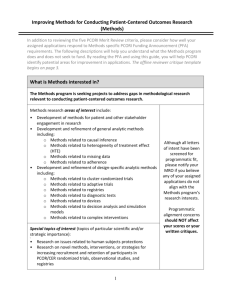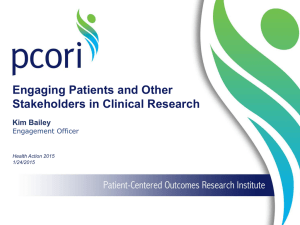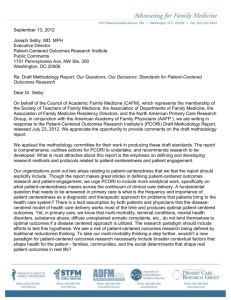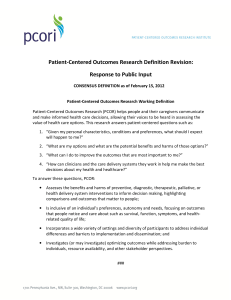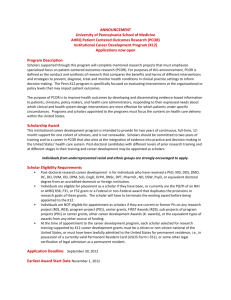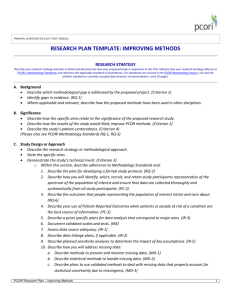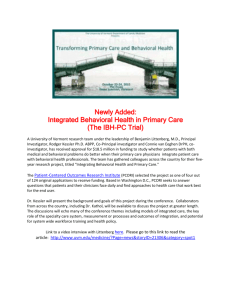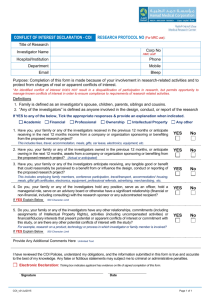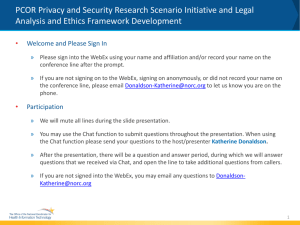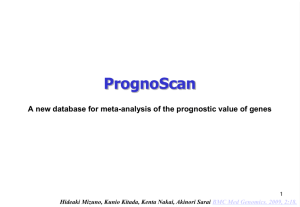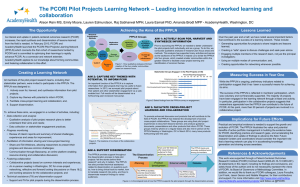Awards up to $5000 - Center for Patient
advertisement
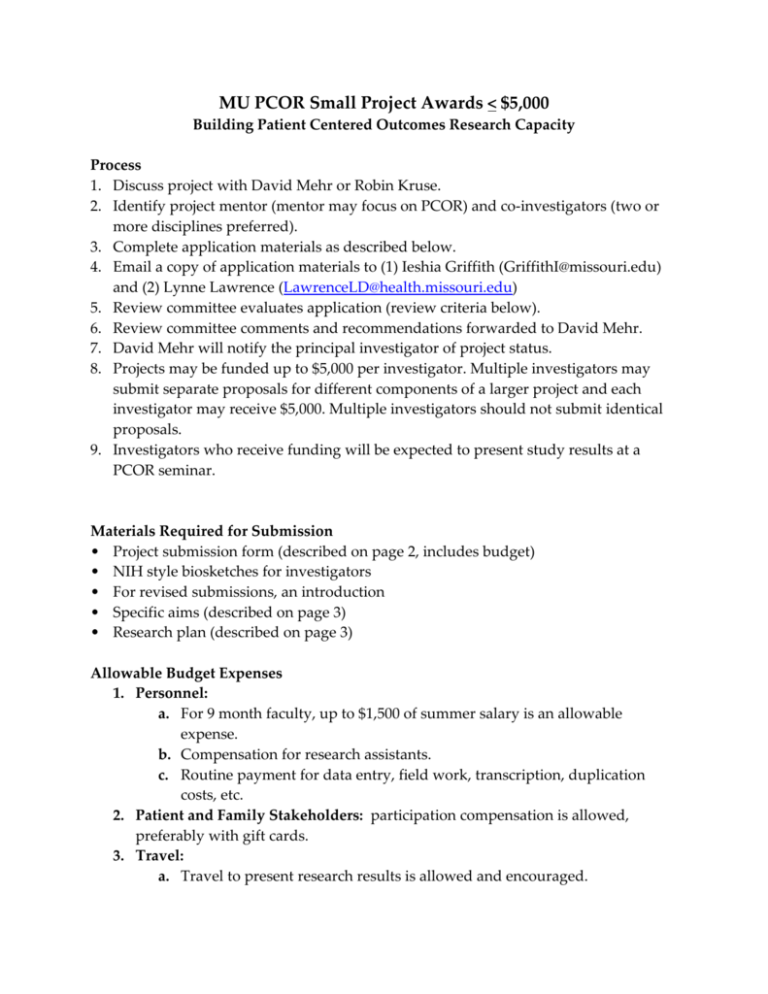
MU PCOR Small Project Awards < $5,000 Building Patient Centered Outcomes Research Capacity Process 1. Discuss project with David Mehr or Robin Kruse. 2. Identify project mentor (mentor may focus on PCOR) and co-investigators (two or more disciplines preferred). 3. Complete application materials as described below. 4. Email a copy of application materials to (1) Ieshia Griffith (GriffithI@missouri.edu) and (2) Lynne Lawrence (LawrenceLD@health.missouri.edu) 5. Review committee evaluates application (review criteria below). 6. Review committee comments and recommendations forwarded to David Mehr. 7. David Mehr will notify the principal investigator of project status. 8. Projects may be funded up to $5,000 per investigator. Multiple investigators may submit separate proposals for different components of a larger project and each investigator may receive $5,000. Multiple investigators should not submit identical proposals. 9. Investigators who receive funding will be expected to present study results at a PCOR seminar. Materials Required for Submission • Project submission form (described on page 2, includes budget) • NIH style biosketches for investigators • For revised submissions, an introduction • Specific aims (described on page 3) • Research plan (described on page 3) Allowable Budget Expenses 1. Personnel: a. For 9 month faculty, up to $1,500 of summer salary is an allowable expense. b. Compensation for research assistants. c. Routine payment for data entry, field work, transcription, duplication costs, etc. 2. Patient and Family Stakeholders: participation compensation is allowed, preferably with gift cards. 3. Travel: a. Travel to present research results is allowed and encouraged. b. Routine travel is allowable at the lowest round-trip fare. Lodging and meal expenses are allowable. 4. Equipment: Applicant should establish that such equipment is not reasonably available elsewhere for the proposed project and is critical to completion of the project. Non-Allowable Budget Expenses Food/consumable supplies MU PCOR Small Project Awards < $5,000 Submission Form 1. Project title: 2. Principal investigator(s)* and qualifications (degrees, very brief description of experience and expertise): 3. Principal investigator(s)* department: 4. Project mentor and qualifications (required): 5. Co-investigators (recommended but not required) and qualifications: 6. Institutions involved: 7. Projected start and end dates: 8. Itemized budget: 9. Budget justification: *Graduate students must be Co-Principal Investigators with their mentor. Submissions for Small Project Awards < $5,000 are limited to two pages of singlespaced text. ABSTRACT Summary of the research that will be performed (limit to one paragraph, not included in page limit) SPECIFIC AIMS In this section, concisely state the goals of the proposed research. Briefly describe the specific aims of the study, including specific research question(s) and the long-term objectives. RESEARCH PLAN A. Background State the problem or question the research is designed to address. Describe the degree to which the condition imposes a significant burden on the health of individuals and/or populations. B. Study Design or Approach Give a concise description of the study population, sample size, the research strategy or methodological approach, and analytic methods that will be employed. Specify the study outcomes and state briefly why these are important to patients. C. Project Milestones Describe the projected outcomes and clearly articulate the proposed goals to be accomplished during the course of the research study. H. Skills to be gained Describe the skills in comparative effectiveness research and/or patient-centered outcomes research that you plan to acquire during the project, and the activities that you plan to acquire them (see list on last page). I. References cited in the application (not included in page limit). Review Criteria Criterion 1. Impact of the condition on the health of individuals and populations The proposal addresses the following questions: • Is the condition or disease associated with a significant burden in the US population, in terms of prevalence, mortality, morbidity, individual suffering, or loss of productivity? • Alternatively, does the condition or disease impose a significant burden on a smaller number of people who have a rare disease? • Does the proposal include a particular emphasis on patients with one or more chronic condition? Criterion 2. Potential for the study to improve health care and outcomes The proposal has the potential to lead to meaningful improvement in the quality and efficiency of care and to improvements in outcomes that are important to patients. It addresses the following questions: • Does the research question address a critical gap in current knowledge as noted in systematic reviews, guideline development efforts, or previous research prioritizations? • Has it been identified as important by patient, caregiver, or clinician groups? • Do wide variations in practice patterns suggest current clinical uncertainty? • Is the research novel or innovative in its methods or approach, in the population being studied, or in the intervention being evaluated, in ways that make it likely to improve care? • Do preliminary studies indicate potential for a sizeable benefit of the intervention relative to current practice? How likely is it that positive findings could be disseminated quickly and affect changes in current practice? Criterion 3. Technical merit The proposal has the technical merit to ensure that the study goals are met. It includes: • A clear research plan with rigorous methods and key milestones clearly articulated • A research team with necessary expertise, and an appropriate project organizational structure • A research environment sufficient to support the conduct of the work with appropriate resources • A diverse study population with respect to age, gender, race, ethnicity, and clinical status as appropriate for research • A focus on a defined population for whom effectiveness information is particularly needed Criterion 4. Patient-centeredness The proposal demonstrates patient-centeredness at every stage of the research. It addresses the following questions: • Is the research focused on questions that affect outcomes of specific interest to patients and their caregivers? • Does the research address one or more of the key questions mentioned in PCORI’s definition of patient-centered outcomes research? • How credible are claims that engaged patients and stakeholders will exert meaningful influence on the design and conduct of the research, to ensure patientcenteredness of the questions and outcomes addressed? Criterion 5. Patient and stakeholder engagement The proposal integrates patients and stakeholders in the development of the research plan and in key elements of conducting the research. It addresses the following questions: • Does the proposal describe how patients and stakeholders were or will be identified and engaged in the research? • Are the roles of patients and key stakeholders significant in formulating the study’s research questions, hypotheses and design and in the study’s conduct and dissemination of results? • Are the roles proposed for patients and stakeholders in any planned dissemination or implementation plans meaningful and likely to be effective? • If engagement is not applicable to the proposed research, does the application justify why it is not? Skills specific to Comparative Effectiveness Research or Patient-Centered Outcomes Research Stakeholder engagement Identifying stakeholder groups Meaningful participation of stakeholders in study design, conduct, and dissemination Determining outcomes that matter to patients Structuring advisory boards Selecting and training stakeholders who participate Retaining stakeholders Working with support groups Supporting interdisciplinary collaboration Building an interdisciplinary team Common understanding of roles and vocabulary Negotiation/conflict management Research designs Comparative effectiveness research Patient-centered outcomes research Pragmatic trials Developing proposals for PCORI Dissemination plan Familiarity with PCORI review criteria Addressing PCOR questions Paying lay participants Review process and scoring Specifying engagement of patients and other stakeholders Disseminating PCOR research results Involving support groups/condition-specific societies Presenting results to a lay audience Role of stakeholders Other issues Mining the PCORI web site for useful information PCOR and CER funding opportunities When to include patients in your IRB application
